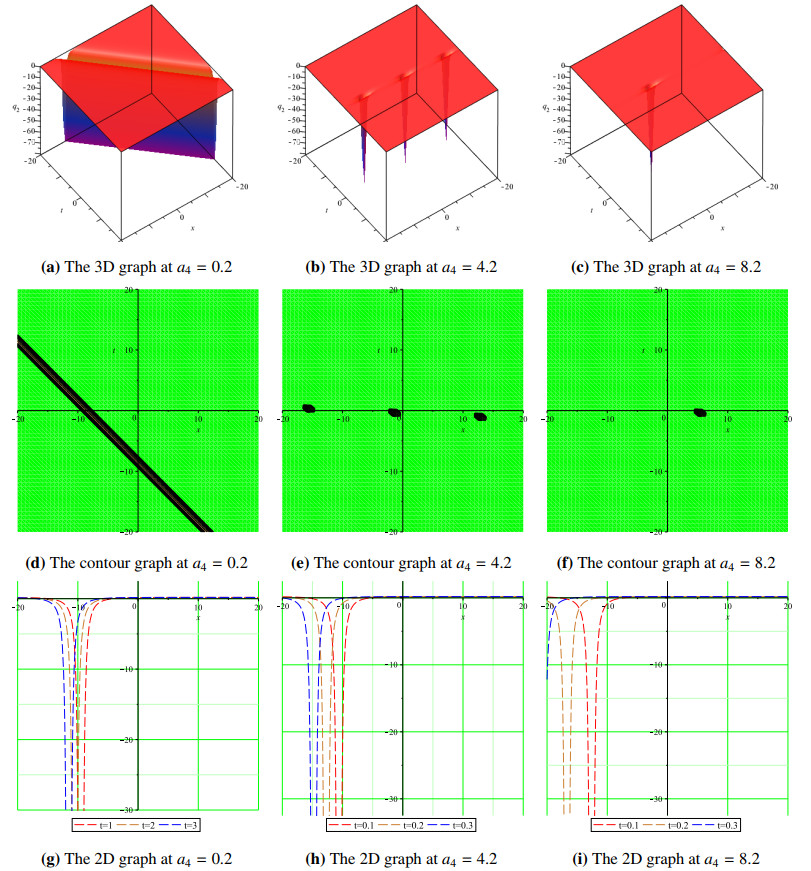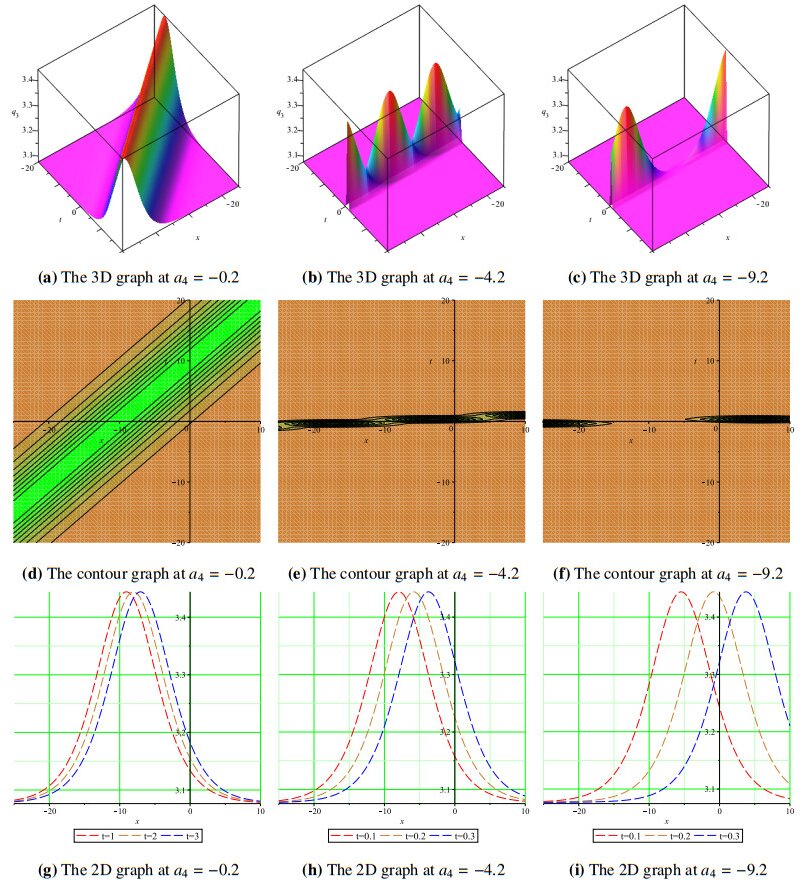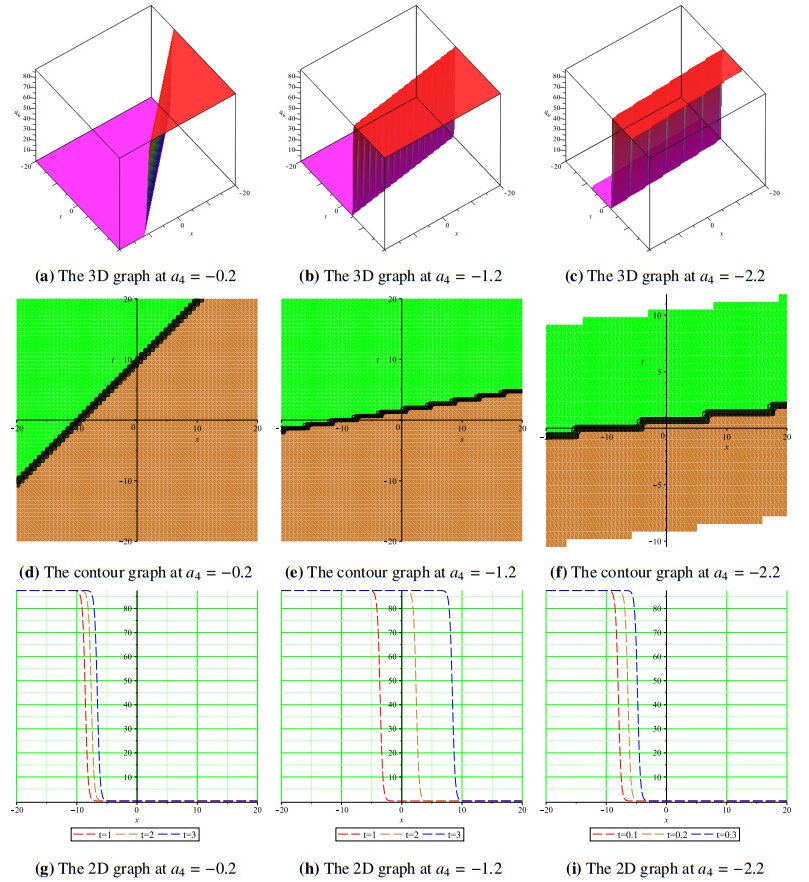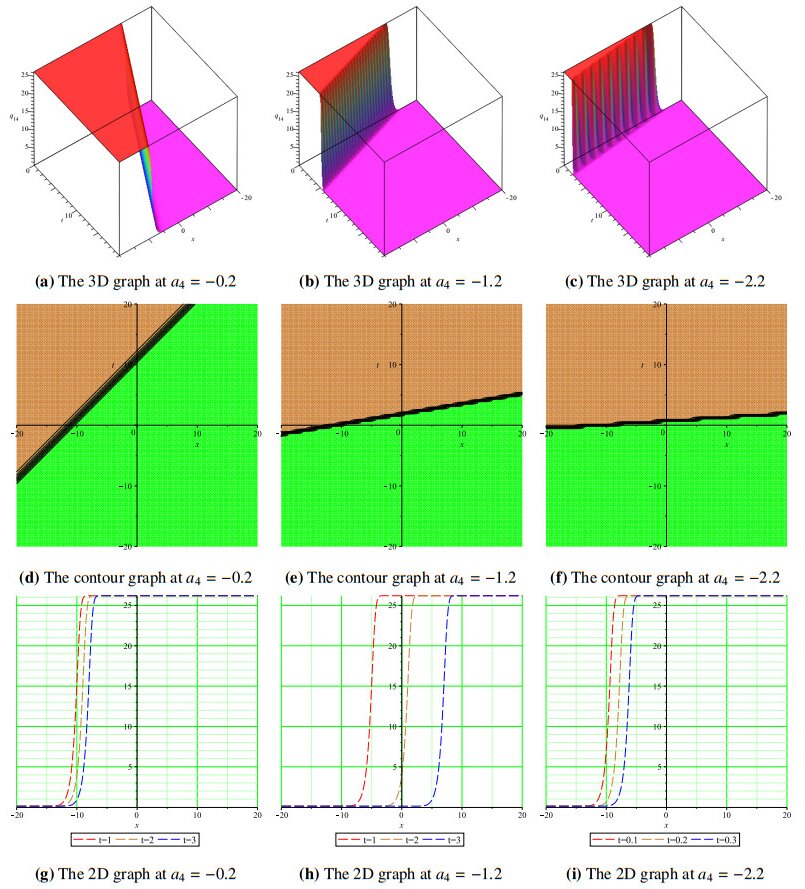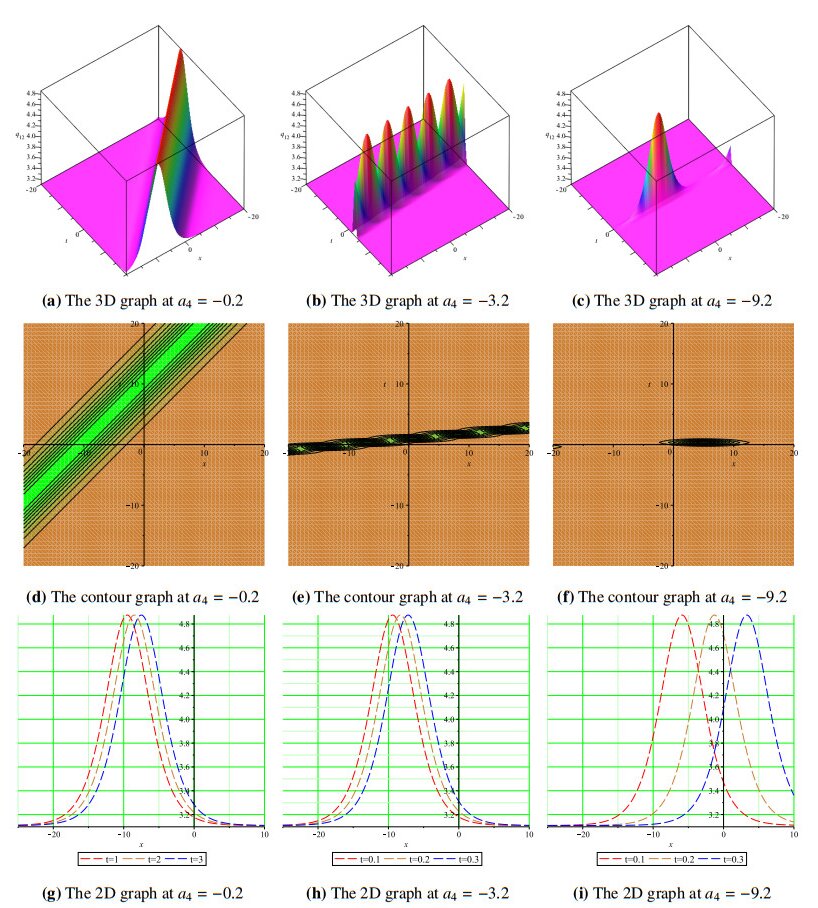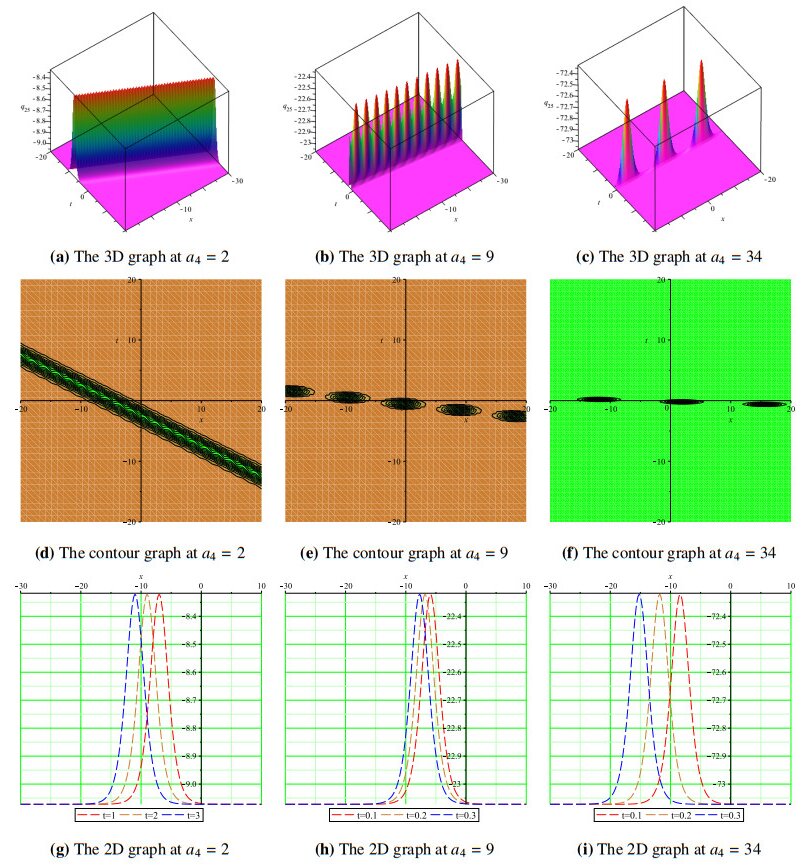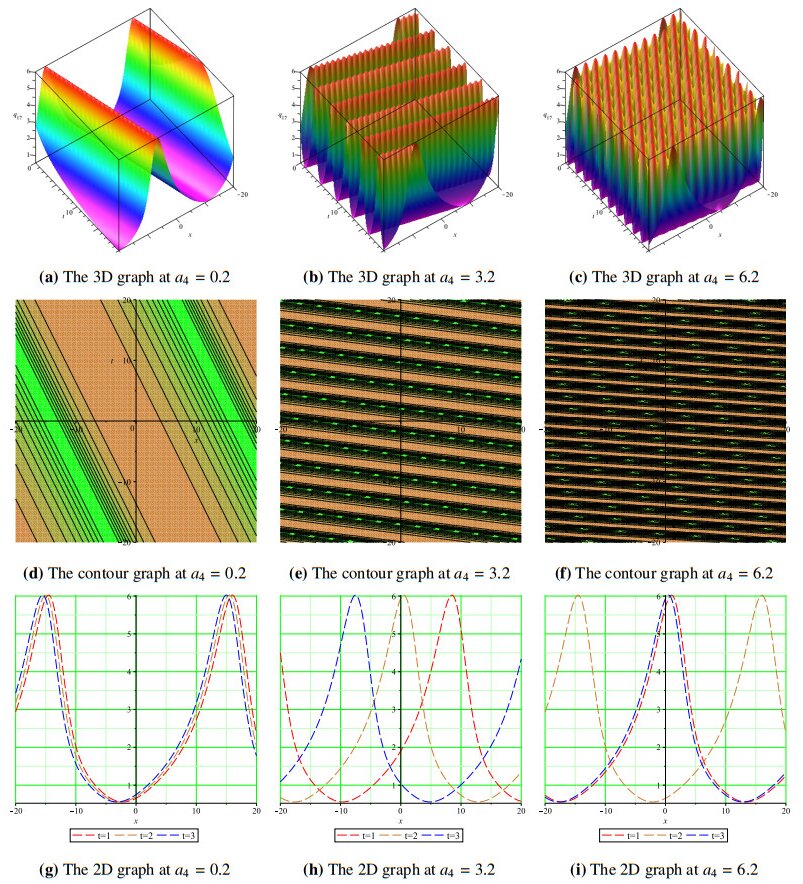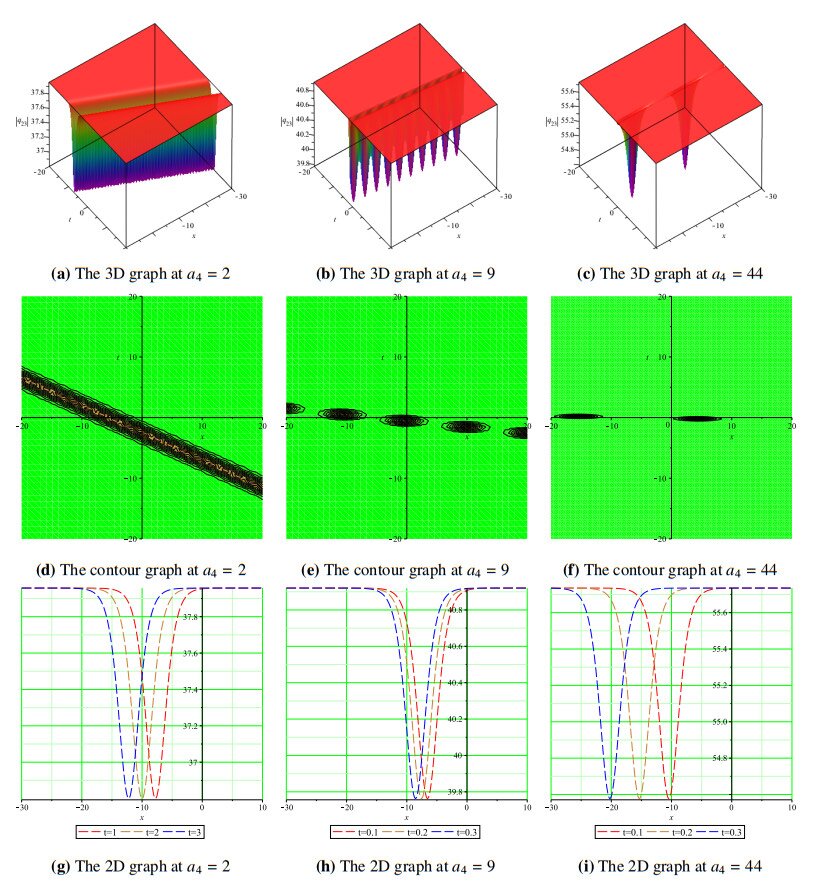1.
Introduction
Nonlinear evolution equations are partial differential equations (PDEs) used to simulate the temporal development of a physical process or system. These equations can be found in all branches of pure and applied sciences, engineering, and social sciences. The most popular among these PDEs include the Navier-Stokes equation [1], Korteweg-de Vries equation [2], Camassa-Holm equation [3], Estevez-Mansfield-Clarkson equation [4], Boussinesq equation [5], Jimbo-Miwa equation [6], Burgers equation [7], and Kadomtsev-Petviashvili equation [8]. Solitons are known for their outstanding ability to balance the effects of dispersion and nonlinearity, to maintain their stability, and to travel over a long distance without experiencing severe distortion. These characteristics have made solitons an effective tool for data transfer in optical communication. Dispersive solitons, also known as optical solitons, are one of the main components of high-speed fiber optic communication systems. Furthermore, understanding the theory of solitons may be used to regulate and improve difficult situations, such as preventing coastal erosion, maximizing wave energy extraction, and developing efficient wave forecasting techniques [9,10]. Rogue waves are space-time solitary waves with a large amplitude that can inflict significant and unanticipated damage to people and valuable assets in and near coastal areas. This has prompted scientists to investigate the fundamental physics of rogue waves and to develop methods for predicting and preventing rogue wave incidents [11,12,13,14].
The generalized (3+1)-D Painlevé-type nonlinear evolution equation (3DPTE) has been developed recently as a model for solitons and related wave phenomena. Based on an assumption of soliton dispersion, Mohan et al. [15] proposed an equation that controls the parameters in rogue waves and related dynamical structures. The new equation is as follows:
where q=q(x,y,z,t) and c1,c2,c3, and c4 are assumed to be real constants. Also, x,y, and z are spatial variables and t is time. This new and unique generalized equation can be used in soliton theory, theory of nonlinear waves, and plasma physics to represent the evolution of instabilities and plasma waves; see [15] for more details on the significance of this new equation and its uniqueness compared to existing equations in the literature. The equation is integrable according to the Painlevé integrability test. It can also have localized solutions such as solitons, lumps, breathers, and others [16].
Many scientists have now focused their attention on investigating the solutions to this equation and other underlying physical phenomena associated with it; for example, various unique methodologies have been developed to obtain solutions to this equation and prove its integrability. Some reviews are as follows: The exp(−Φ(ξ))-expansion and tanh-function methods have been used to produce various solutions to the 3DPTE [17]. The N-rogue generalized wave expression for extraction of solutions using the modified Hirota technique was fully studied in [18]. Exponential rational function solutions have also been obtained for the 3DPTE model via the generalized exponential function technique [19]. The integrability and soliton solution have been obtained using the novel bilinear Bäcklund transformation and Hirota bilinear form methods [20]. Rogue wave solutions with center parameters have been derived through the generalized direct formula scheme [21]. Moreover, using the Hirota bilinear method, the one, two, and three solitons for the 3DPTE have been extracted [22].
There are many novel approaches for solving nonlinear evolution equations, ranging from numerical, semi-analytical, and analytical methods. Moreover, some of the most commonly utilized numerical schemes are the probabilistic numerical scheme [23], the Bayesian numerical methods [24], the energy methods for free boundary problems [25], the modified method of approximate solutions [26], the novel mesh-free methods [27], the empirical inter-scale finite element method [28], the semi-analytical method of lines [29], and the nonstandard finite difference method [30]. However, this study focuses on solitary wave techniques for deriving exact solutions to nonlinear PDEs. Popular examples of these techniques include the modified simple equation technique [31], the rational function technique [32], the exponential function technique [33], the extended tanh-function approach [34], the generalized hyperbolic-function scheme [35], the generalized Kudryashov technique [36], the improved Sadar subequation methods [37,38], the auxiliary equation technique [39], the generalized Riccati equation techniques [40], the modified Jacobi elliptic function method [41], the extended direct algebra methods [42,43], and others. Now, motivated by the above techniques for deriving solitary wave solutions of the 3DPTE, we will use the improved generalized Riccati equation (IGRE) method [43] and the generalized Kudryashov (GK) method [44] to derive more concise and generalized solitary wave solutions for the new generalized 3DPTE equation. The IGRE method is efficient and reliable for producing succinct and more general hyperbolic and trigonometric function solutions to nonlinear PDEs, while the GK method is robust in establishing succinct and general rational and exponential function solutions to nonlinear PDEs.
The remaining sections of this paper are organized as follows. In Section 2, a brief description is given of the procedures of the IGRE and GK methods. In Section 3, the two methods are applied to derive solitary wave solutions of the Painlevé equation. In Section 4, graphs of some selected solutions are plotted to illustrate various soliton structures. Finally, Section 5 contains the conclusions for the paper.
2.
Description of the IGRE and the GK methods
This section briefly describes the IGRE and GK methods for solving general nonlinear PDEs (NPDEs). The two improved methods are developed based on the fact that the solutions of many nonlinear equations can be represented by a finite series of tanh functions. This acted as a motivation to Fan in [34] to replace the tanh function with the solution of the Riccati equation:
where m is a parameter to be determined. This idea yielded various solitary wave solutions for the NPDEs. Apart from the different forms of the periodic and singular solutions, the sign of m in the Riccati equation also determines the number and type of traveling wave solutions for the NPDEs. In the same vein, Kudryashov [45] proposed his method by replacing the tanh function with the solution of Eq (2.7). These methods proved to be robust and reliable methods for finding different solutions of the NPDEs. The IGRE method provides the solution of the NPDEs using the generalized Riccati equation in Eq (2.5), and the GK method is based on the idea of representing the solution of nonlinear equation by a finite series of rational functions. Now we are going to provide the detail procedures for the IGRE and GK methods for solving general nonlinear NPDEs. For any given NPDE of the form:
we apply a wave variable of the form ξ=a1x+a2y+a3z+a4t, where a1,a2,a3,a4 are constants, and then let u(ξ)=q(x,y,z,t). This will convert Eq (2.2) into an ordinary differential equation:
where u′(ξ)=du(ξ)dξ,u″(ξ)=d2u(ξ)dξ2, and so on. We next assume that the solution of Eq (2.3) is of the form:
where bi for all i=1,2,…,N will be determined later with bN≠0, and N will be calculated using the homogeneous balancing method (HBM), that is, by balancing the highest derivative term with the nonlinear term in Eq (2.3). As the next step in the IGRE method, the function Ω(ξ) is assumed to satisfy the following generalized Riccati equation:
where m0,m1, s and m2 are constants. Equation 2.5 has many solutions; see [37] for the different solutions of Eq (2.5).
Alternatively, as the next step in the GK method, the solution of Eq (2.3) is assumed to be of the form:
where bi(i=0,1,...,P) and fj(j=0,1,...,Q) will be determined later such that bP≠0 and fQ≠0. The integers P and Q will be calculated using the HBM. Moreover, the function Ω(ξ) is assumed to satisfy
It is not difficult to see that the function
satisfies Eq (2.7). Details on the GK method can be found in [44].
The two methods described here will be applied to derive new wave solutions to the 3DPTE in the following section. These methods have proved to be effective for analyzing a wide range of traveling wave solutions for nonlinear PDEs, including exponential, rational, trigonometric, and hyperbolic function solutions with interesting wave profile patterns. This is the primary basis for their selection in this work.
3.
Applications of the IGRE and the GK methods
This section contains a range of wave solutions for the 3DPTE in Eq (1.1) using the IGRE and the GK methods. We begin by transforming Eq (1.1) into a nonlinear ordinary differential equation (NODE) via the following wave transformation:
Then, we have
Next, we determine the values of the balance numbers N, P, and Q using HBM to implement the methods described in Section 2.
3.1. Solitary wave solutions using the IGRE method
In this section, the IGRE method is used to obtain solitary wave solutions to the 3DPTE. Now, balancing the terms u(4) with (u′)2, we get N=2. By putting N=2 into Eq (2.4), we have
Substituting Eq (3.3) into Eq (3.2) by using Eq (2.5) and setting the coefficients of Ωi(ξ) to zero, we obtain the equations:
Upon solving the above equations using Maple, we obtain the following solution:
We consider the following two cases.
Case 1: When b21c22m22a41−576m0m2≥0. Substituting Eq (3.5) into Eq (3.3) and using the solutions of Eq (2.5), we obtain the following hyperbolic function solutions for PDE (1.1):
Case 2: When 576m0m2−b21c22m22a41≥0. In this case, the following trigonometric function solutions can be obtained by substituting Eq (3.5) into Eq (3.3) and using the solutions of Eq (2.5).
3.2. Solitary wave solutions using the GK method
This section will use the GK method to provide different solitary wave solutions of the 3DPTE in Eq (1.1). Now, balance u(4) with (u′)2 in Eq (3.2) to get P=Q+2. If we let Q=1, then P=3, and from Eq (2.6), the solution takes the following form:
If we substitute Eq (3.28) into Eq (3.2), using Eq (2.7) and equating the coefficients of Ωi(ξ) to zero, then we obtain the following algebraic equations:
Using a symbolic software package to solve the above equations, one gets the following sets of solutions:
Set 1.
Set 2.
Set 3.
Set 4.
Substitute the solutions obtained from Set 1 into Eq (3.28) to obtain the following solutions for Eq (1.1) as
Similarly, substituting the solutions from Set 2 into Eq (3.28), we have
Again, substituting the solutions obtained from Set 3 into Eq (3.28), we get
Lastly, substituting the solutions obtained from Set 4 into Eq (3.28), we obtain
4.
Graphical results and discussion
This paper derives traveling wave solutions for the newly introduced 3DPTE in Eq (1.1) by using the IGRE and GK methods. We have obtained four different rational exponential function solutions for the considered equation using the GK method. These exponential rational function solutions are entirely different from three exponential function solutions reported in [22]. Hence, the exponential rational function solutions are new and have never been reported in previous studies. Using the IGRE method, we have obtained a total of twenty-two trigonometric and hyperbolic function solutions and mixed trigonometric and hyperbolic function solutions. These solutions are more succinct and general than those reported in [17,18,19,20,21]. Additionally, the majority of the derived solutions in this study are hyperbolic and trigonometric functions that may result in different periodic structures. Periodic soliton disturbances in optical fibers help us comprehend ultra-short pulse lasers and long-distance optical communication networks. Furthermore, trigonometric and hyperbolic functions, as well as complex structures, have a vital role in determining optical characteristics. Thus, the proposed solutions may have numerous potential uses in nano and optical fibers. Solutions with cotangent hyperbolic functions are specifically relevant to magnetic polarization since they may be found in the Langevin function. Tangent hyperbolic functions can be employed in special relativistic and magnetic moment computations. Hyperbolic secant solutions are known to be useful in laminar jets [46].
Moreover, using different x,t domains, we have studied the wave propagation profiles of the proposed solutions as displayed in 3D, contour, and 2D plots at different time levels. Since rogue waves are space-time solitary waves with a large amplitude, we varied the wave amplitudes of the displayed solutions in our simulations to report 3D, contour and 2D graphs of some of a range of solutions. Figure 1(a, b) shows Kuztnetsov-Ma-like breathers at a4=2.5, a4=3.5, and Figure 1(c) shows a Peregrine-like soliton a4=5.5 for the solutions q1. The same is demonstrated using contour plots in Figure 1(d–f), while Figure 1(g–i) displays 2D plots of the solution q1 at different time levels. Figure 2(a) demonstrates the dark wave propagation for solution q2, as the amplitude is increased from a4=0.2 to a4=4.2 and a4=8.2, and we obtain two different breather solitons in Figure 2(b, c). The corresponding contour and 2D graphs are also shown in Figure 2(d–i) for the soliton solution q2. Figure 3(a) shows the bright-soliton wave profile at a4=−0.2 and at a4=−4.2 and a4=−9.2, and we recovered Kuztnetsov-Ma-like breathers shown in Figure 3(b, c). Figure 3(d–i) are the corresponding contour and 2D plots for the solution q3. Figures 4 and 5 represent the kink soliton profiles for the solution q6 in 3D, contour, and 2D plots at different amplitudes.
In addition, Figures 6 and 7 represent the evolution of bright solitons to different forms of breather waves in 3D, 2D, and contour plots as the amplitudes are varied. Figure 8(d–i) shows the evolution of different periodic soliton patterns for the solution q17 at a4=0.2, a4=3.2, and a4=6.2, This type of soliton perturbations help us to understand ultra-short pulse lasers and long-distance optical communication networks.
Figure 9(d–i) shows the evolution of dark wave solitons into breather waves at a4=2, a4=9, and a4=44 for the solution q23. We also noticed that the solutions obtained using the GK method require larger amplitudes before they are transformed into different forms of rogue waves that include the Peregrine soliton and Kuztnetsov-Ma breather. All wave profiles presented in this study are based on assigning appropriate values to the free parameters listed in each figure's caption.
5.
Conclusions
This study investigated diverse wave solutions for the newly introduced 3DPTE using the IGRE and GK methods. We derived various wave solutions for the 3DPTE based on wave transformation and the homogeneous balancing method. The solutions included rational exponential, trigonometric, and hyperbolic function solutions. The 3DPTE is considered to have various applications in soliton theory, nonlinear waves, and plasma physics including the evolution of plasma waves and instabilities. We studied the wave propagation phenomena in the derived solutions using 3D, 2D, and contour plots by assigning appropriate values to the real variables. We studied the wave instabilities of the recovered solutions by varying the value of the wave amplitude. We observed the transformation of dark and bright solitons into different forms of rogue waves that include Peregrine soliton and Kuztnetsov-Ma breather as we increased the value of the wave amplitude. Other intriguing wave patterns in this work include the kink and multi-wave profiles.
This research on the 3DPTE and recovered solutions should significantly advance wave instabilities in soliton theory. It can also be used in preventing coastal erosion and ensuring marine safety, maximizing wave energy extraction, developing efficient wave forecasting techniques, and many other important application areas for this equation. In addition, most of the derived solutions in this study are hyperbolic and trigonometric functions providing periodic structures. Ultra-short pulse lasers and long-distance optical communication networks are obtained by periodic soliton disturbances in optical fibers. Moreover, a vital role in determining optical properties can be found from trigonometric and hyperbolic functions and complex structures. Therefore, the proposed solutions can be potentially applied to nano and optical fibers. Cotangent hyperbolic function solutions are specifically relevant to magnetic polarization because they may be found in the Langevin function. Tangent hyperbolic function solutions can be utilized in special relativistic and magnetic moment computations. Applications in laminar jets can be studied using hyperbolic secant solutions. Finally, the used methods proved to be efficient techniques for investigating a wide range of traveling wave solutions for the 3DPTE.
Therefore, we strongly recommend these methods for the studies and beyond. Investigating the chaotic behavior and fractional aspects of the 3DPTE will be an intriguing future direction utilizing more efficient methods.
Author contributions
S. Sirisubtawee, S. Sungnul and M. Inc: Conceptualization, Methodology, Writing–review and editing; J. Sabi'u and S. Sirisubtawee: Formal analysis, Investigation, Writing–original draft. All authors have read and approved the final version of the manuscript for publication.
Acknowledgments
This research was funded by King Mongkut's University of Technology North Bangkok with Contract no. KMUTNB-67-KNOW-18. In addition, the first author was financially supported by King Mongkut's University of Technology North Bangkok with contract no. KMUTNB-Post-67-05.
Conflict of interest
The authors declare that they have no conflicts of interest.










 DownLoad:
DownLoad:
